ESP Seat Mii 2015 SOUND SYSTEM 1.X
[x] Cancel search | Manufacturer: SEAT, Model Year: 2015, Model line: Mii, Model: Seat Mii 2015Pages: 36, PDF Size: 0.87 MB
Page 2 of 36
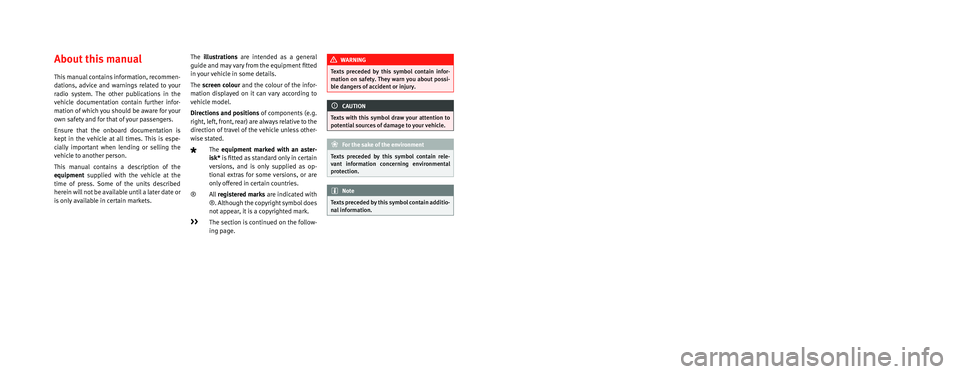
SEAT S.A. is permanently concerned about continuous development of its t\
ypes and models. For this reason we ask you to under-
stand, that at any given time, changes regarding shape, equipment and te\
chnique may take place on the car delivered. For this reason
no right at all may derive based on the data, drawings and descriptions \
in this current handbook.
All texts, illustrations and standards in this handbook are based on the\
status of information at the time of printing. Except for error
or omission, the information included in the current handbook is valid a\
s of the date of closing print.
Re-printing, copying or translating, whether total or partial is not all\
owed unless SEAT allows it in written form.
SEAT reserves all rights in accordance with the “Copyright” Act.
All rights on changes are reserved.
❀This paper has been manufactured using bleached non-chlorine cellulose.
© SEAT S.A. - Reprint: 15.05.15
About this manual
This manual contains information, recommen-
dations, advice and warnings related to your
radio system. The other publications in the
vehicle documentation contain further infor -
mation of which you should be aware for your
own safety and for that of your passengers.
Ensure that the onboard documentation is
kept in the vehicle at all times. This is espe -
cially important when lending or selling the
vehicle to another person.
This manual contains a description of the
equipment supplied with the vehicle at the
time of press. Some of the units described
herein will not be available until a later date or
is only available in certain markets. The
illustrations are intended as a general
guide and may vary from the equipment �tted
in your vehicle in some details.
The screen colour and the colour of the infor -
mation displayed on it can vary according to
vehicle model.
Directions and positions of components (e.g.
right, left, front, rear) are always relative to the
direction of travel of the vehicle unless other -
wise stated.
The equipment marked with an aster -
isk* is �tted as standard only in certain
versions, and is only supplied as op -
tional extras for some versions, or are
only offered in certain countries.
® All registered marks are indicated with
®. Although the copyright symbol does
not appear, it is a copyrighted mark.
>> The section is continued on the follow -
ing page.
WARNING
Texts preceded by this symbol contain infor -
mation on safety. They warn you about possi -
ble dangers of accident or injury.
CAUTION
Texts with this symbol draw your attention to
potential sources of damage to your vehicle.
For the sake of the environment
Texts preceded by this symbol contain rele-
vant information concerning environmental
protection.
Note
Texts preceded by this symbol contain additio -
nal information.
Page 6 of 36
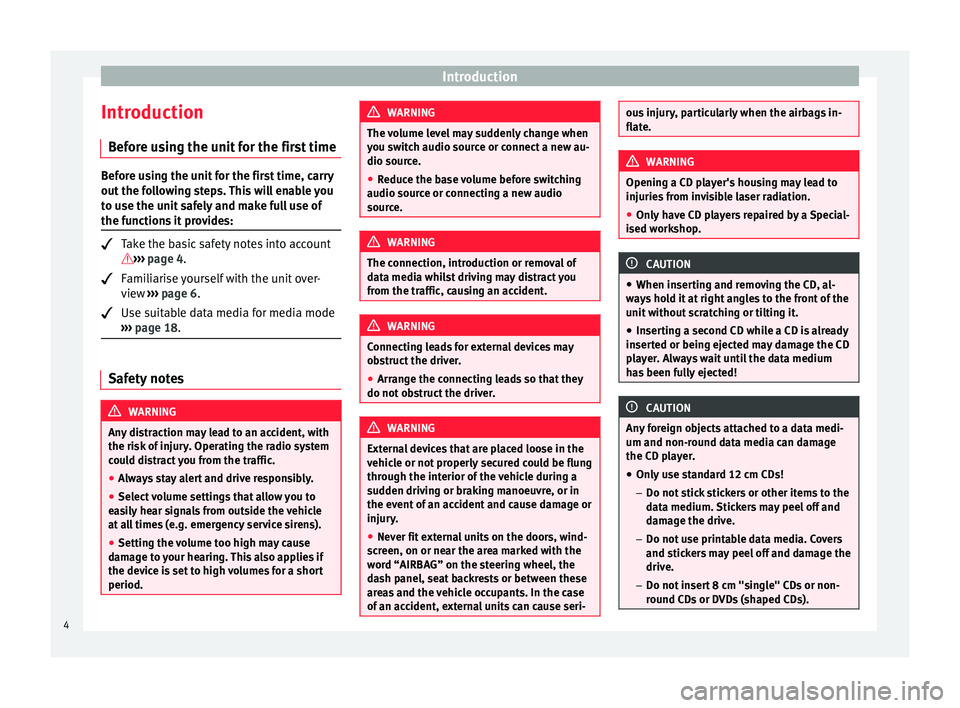
Introduction
Introduction B ef
or
e using the unit for the first time Before using the unit for the first time, carry
out the f
o
llowing steps. This will enable you
to use the unit safely and make full use of
the functions it provides:
Take the b
asic safety notes into account
››› page 4.
Familiarise yourself with the unit over-
view
››› page 6.
Use suitable data media for media mode
››› page 18. Safety notes
WARNING
Any distraction may lead to an accident, with
the risk of
injury. Operating the radio system
could distract you from the traffic.
● Always stay alert and drive responsibly.
● Select volume settings that allow you to
eas
ily hear signals from outside the vehicle
at all times (e.g. emergency service sirens).
● Setting the volume too high may cause
damag
e to your hearing. This also applies if
the device is set to high volumes for a short
period. WARNING
The volume level may suddenly change when
you sw it
ch audio source or connect a new au-
dio source.
● Reduce the base volume before switching
audio source or c
onnecting a new audio
source. WARNING
The connection, introduction or removal of
dat a medi
a whilst driving may distract you
from the traffic, causing an accident. WARNING
Connecting leads for external devices may
ob s
truct the driver.
● Arrange the connecting leads so that they
do not ob
struct the driver. WARNING
External devices that are placed loose in the
vehic l
e or not properly secured could be flung
through the interior of the vehicle during a
sudden driving or braking manoeuvre, or in
the event of an accident and cause damage or
injury.
● Never fit external units on the doors, wind-
scr
een, on or near the area marked with the
word “AIRBAG” on the steering wheel, the
dash panel, seat backrests or between these
areas and the vehicle occupants. In the case
of an accident, external units can cause seri- ous injury, particularly when the airbags in-
flat
e. WARNING
Opening a CD player's housing may lead to
injurie s fr
om invisible laser radiation.
● Only have CD players repaired by a Special-
ised work
shop. CAUTION
● When in sertin
g and removing the CD, al-
ways hold it at right angles to the front of the
unit without scratching or tilting it.
● Inserting a second CD while a CD is already
insert
ed or being ejected may damage the CD
player. Always wait until the data medium
has been fully ejected! CAUTION
Any foreign objects attached to a data medi-
um and non-rou nd d
ata media can damage
the CD player.
● Only use standard 12 cm CDs!
– Do not stic
k stickers or other items to the
data medium. Stickers may peel off and
damage the drive.
– Do not use printable data media. Covers
and stickers may peel off and damage the
drive.
– Do not insert 8 cm "single" CDs or non-
round CDs or DVDs (shaped CDs). 4
Page 10 of 36
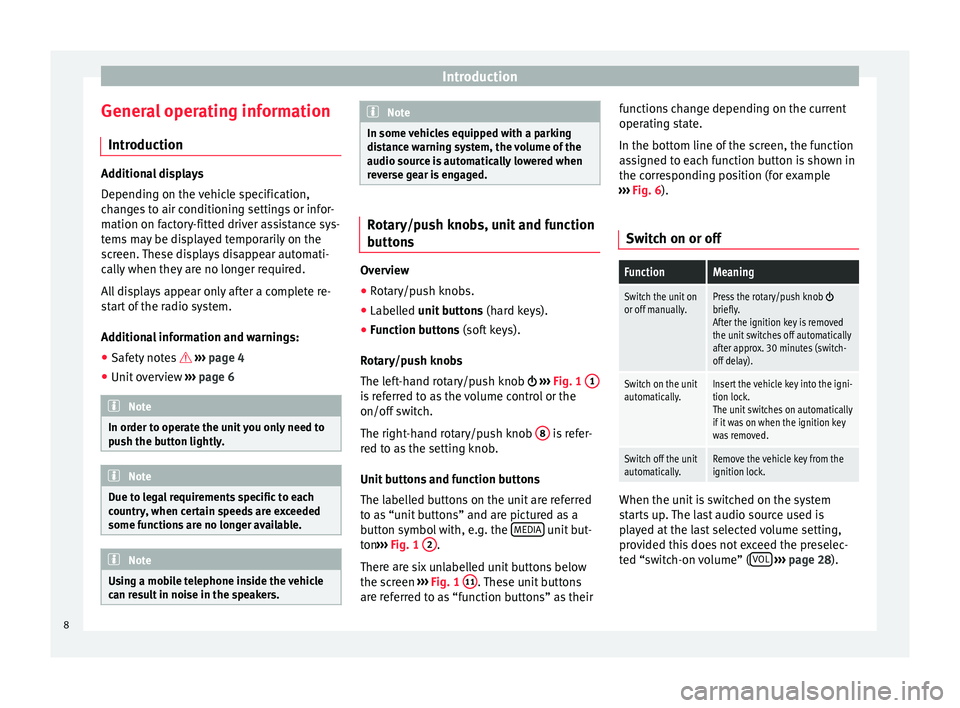
Introduction
General operating information Intr oduction Additional displays
Dependin
g on the
vehicle specification,
changes to air conditioning settings or infor-
mation on factory-fitted driver assistance sys-
tems may be displayed temporarily on the
screen. These displays disappear automati-
cally when they are no longer required.
All displays appear only after a complete re-
start of the radio system.
Additional information and warnings:
● Safety notes ››
›
page 4
● Unit overview ›››
page 6 Note
In order to operate the unit you only need to
pu sh the b
utton lightly. Note
Due to legal requirements specific to each
cou ntr
y, when certain speeds are exceeded
some functions are no longer available. Note
Using a mobile telephone inside the vehicle
can r e
sult in noise in the speakers. Note
In some vehicles equipped with a parking
dis t
ance warning system, the volume of the
audio source is automatically lowered when
reverse gear is engaged. Rotary/push knobs, unit and function
butt
on
s Overview
● Rotary/push knobs.
● Labelled u nit buttons (har
d keys).
● Function buttons (soft k
eys).
Rotary/push knobs
The left-hand rotary/push knob ›››
Fig. 1 1 is referred to as the volume control or the
on/off
sw
it
ch.
The right-hand rotary/push knob 8 is refer-
r ed t
o a
s the setting knob.
Unit buttons and function buttons
The labelled buttons on the unit are referred
to as “unit buttons” and are pictured as a
button symbol with, e.g. the MEDIA unit but-
t on ›
›
› Fig. 1 2 .
Ther e ar
e s
ix unlabelled unit buttons below
the screen ›››
Fig. 1 11 . These unit buttons
ar e r
ef
erred to as “function buttons” as their functions change depending on the current
operating s
tate.
In the bottom line of the screen, the function
assigned to each function button is shown in
the corresponding position (for example
››› Fig. 6).
Switch on or off
FunctionMeaning
Switch the unit on
or off manually.Press the rotary/push knob briefly.
After the ignition key is removed
the unit switches off automatically
after approx. 30 minutes (switch- off delay).
Switch on the unit
automatically.Insert the vehicle key into the igni-
tion lock.
The unit switches on automatically
if it was on when the ignition key
was removed.
Switch off the unit
automatically.Remove the vehicle key from the
ignition lock. When the unit is switched on the system
s
t
ar
ts up. The last audio source used is
played at the last selected volume setting,
provided this does not exceed the preselec-
ted “switch-on volume” ( VOL
› ›
›
page 28).
8
Page 16 of 36
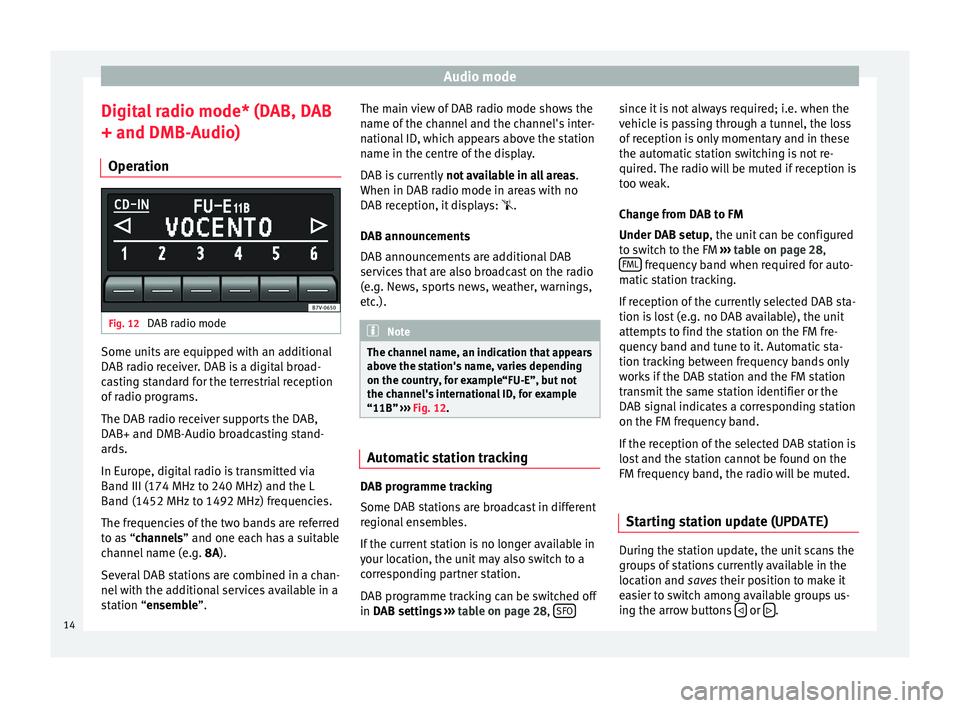
Audio mode
Digital radio mode* (DAB, DAB
+ and DMB-Audio) Oper ation Fig. 12
DAB radio mode Some units are equipped with an additional
D
AB r
a
dio receiver. DAB is a digital broad-
casting standard for the terrestrial reception
of radio programs.
The DAB radio receiver supports the DAB,
DAB+ and DMB-Audio broadcasting stand-
ards.
In Europe, digital radio is transmitted via
Band III (174 MHz to 240 MHz) and the L
Band (1452 MHz to 1492 MHz) frequencies.
The frequencies of the two bands are referred
to as “channels” and one each has a suitable
channel name (e.g. 8A).
Several DAB stations are combined in a chan-
nel with the additional services available in a
station “ensemble”. The main view of DAB radio mode shows the
name of the c
hannel and the channel's inter-
national ID, which appears above the station
name in the centre of the display.
DAB is currently not available in all areas .
When in DAB radio mode in areas with no
DAB reception, it displays: .
DAB announcements
DAB announcements are additional DAB
services that are also broadcast on the radio
(e.g. News, sports news, weather, warnings,
etc.). Note
The channel name, an indication that appears
abov e the s
tation's name, varies depending
on the country, for example“FU-E”, but not
the channel's international ID, for example
“11B” ››› Fig. 12. Automatic station tracking
DAB programme tracking
Some D
AB s
t
ations are broadcast in different
regional ensembles.
If the current station is no longer available in
your location, the unit may also switch to a
corresponding partner station.
DAB programme tracking can be switched off
in DAB settings ›››
table on page 28, SFO since it is not always required; i.e. when the
v
ehic
l
e is passing through a tunnel, the loss
of reception is only momentary and in these
the automatic station switching is not re-
quired. The radio will be muted if reception is
too weak.
Change from DAB to FM
Under DAB setup, the unit can be configured
to switch to the FM ››› table on page 28,
FML frequency band when required for auto-
m atic
s
tation tracking.
If reception of the currently selected DAB sta-
tion is lost (e.g. no DAB available), the unit
attempts to find the station on the FM fre-
quency band and tune to it. Automatic sta-
tion tracking between frequency bands only
works if the DAB station and the FM station
transmit the same station identifier or the
DAB signal indicates a corresponding station
on the FM frequency band.
If the reception of the selected DAB station is
lost and the station cannot be found on the
FM frequency band, the radio will be muted.
Starting station update (UPDATE ) During the station update, the unit scans the
gr
oup
s
of stations currently available in the
location and saves their position to make it
easier to switch among available groups us-
ing the arrow buttons or
.
14
Page 20 of 36
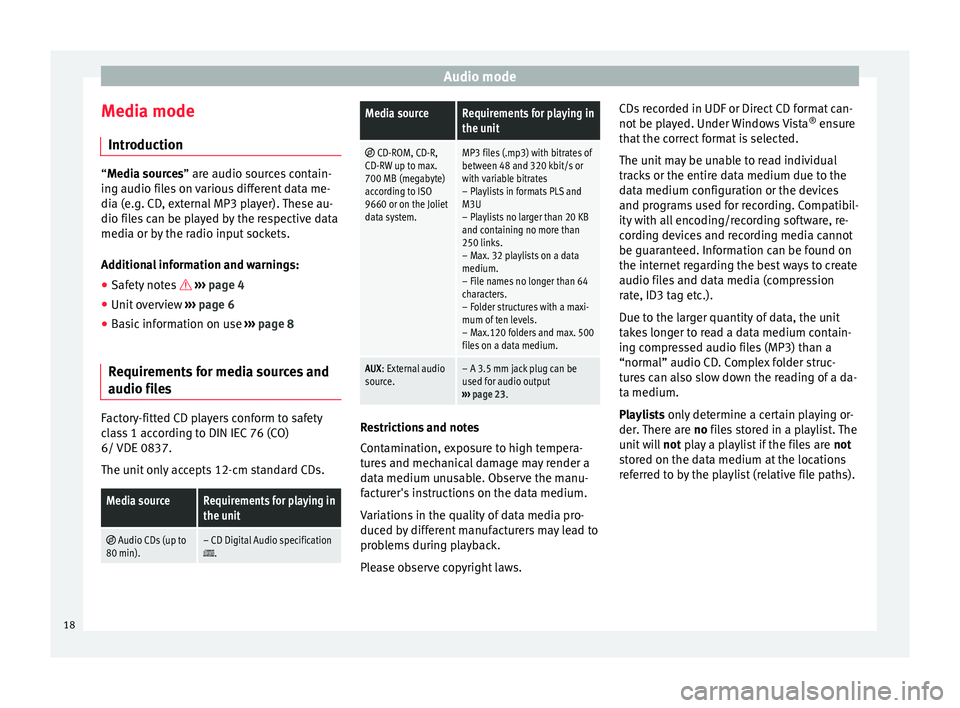
Audio mode
Media mode Intr oduction “Media sources” are audio sources contain-
in g audio fi
les on various different data me-
dia (e.g. CD, external MP3 player). These au-
dio files can be played by the respective data
media or by the radio input sockets.
Additional information and warnings:
● Safety notes ›››
page 4
● Unit overview ›››
page 6
● Basic information on use ›››
page 8
Requirements for media sources and
audio file
sFactory-fitted CD players conform to safety
c
l
a
ss 1 according to DIN IEC 76 (CO)
6/ VDE 0837.
The unit only accepts 12-cm standard CDs.
Media sourceRequirements for playing in
the unit
Audio CDs (up to
80 min).– CD Digital Audio specification.
Media sourceRequirements for playing in
the unit
CD-ROM, CD-R,
CD-RW up to max.
700 MB (megabyte)
according to ISO
9660 or on the Joliet
data system.MP3 files (.mp3) with bitrates of
between 48 and 320 kbit/s or
with variable bitrates
– Playlists in formats PLS and
M3U
– Playlists no larger than 20 KB
and containing no more than
250 links.
– Max. 32 playlists on a data
medium.
– File names no longer than 64
characters.
– Folder structures with a maxi-
mum of ten levels.
– Max.120 folders and max. 500
files on a data medium.
AUX : External audio
source.– A 3.5 mm jack plug can be
used for audio output
››› page 23. Restrictions and notes
C
ont
amin
ation, exposure to high tempera-
tures and mechanical damage may render a
data medium unusable. Observe the manu-
facturer's instructions on the data medium.
Variations in the quality of data media pro-
duced by different manufacturers may lead to
problems during playback.
Please observe copyright laws. CDs recorded in UDF or Direct CD format can-
not be pl
ayed. Under Windows Vista ®
ensure
that the correct format is selected.
The unit may be unable to read individual
tracks or the entire data medium due to the
data medium configuration or the devices
and programs used for recording. Compatibil-
ity with all encoding/recording software, re-
cording devices and recording media cannot
be guaranteed. Information can be found on
the internet regarding the best ways to create
audio files and data media (compression
rate, ID3 tag etc.).
Due to the larger quantity of data, the unit
takes longer to read a data medium contain-
ing compressed audio files (MP3) than a
“normal” audio CD. Complex folder struc-
tures can also slow down the reading of a da-
ta medium.
Playlists only determine a certain playing or-
der. There are no files stored in a playlist. The
unit will not play a playlist if the files are not
stored on the data medium at the locations
referred to by the playlist (relative file paths).
18
Page 24 of 36
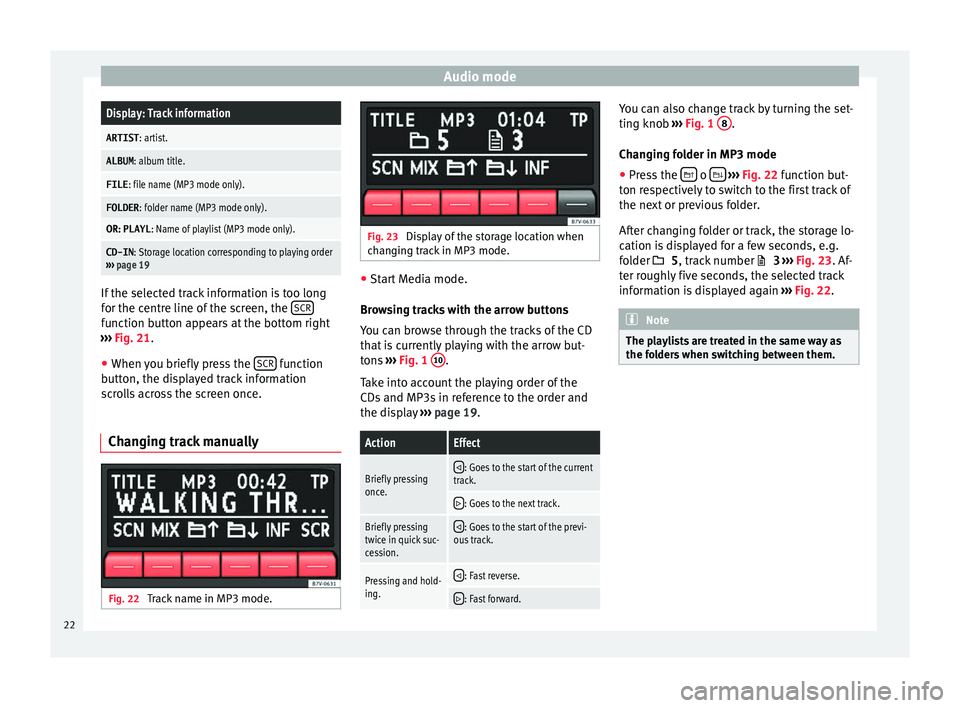
Audio modeDisplay: Track information
ARTIST
: artist.
ALBUM: album title.
FILE: file name (MP3 mode only).
FOLDER : folder name (MP3 mode only).
OR: PLAYL : Name of playlist (MP3 mode only).
CD-IN: Storage location corresponding to playing order
››› page 19 If the selected track information is too long
f
or the c
entr
e line of the screen, the SCRfunction button appears at the bottom right
› ›
›
Fig. 21.
● When you briefly press the SCR function
b utt
on, the di
splayed track information
scrolls across the screen once.
Changing track manually Fig. 22
Track name in MP3 mode. Fig. 23
Display of the storage location when
c h
an
ging track in MP3 mode. ●
Start Media mode.
Bro w
sing tracks with the arrow buttons
You can browse through the tracks of the CD
that is currently playing with the arrow but-
tons ››› Fig. 1 10 .
T ak
e int
o account the playing order of the
CDs and MP3s in reference to the order and
the display ››› page 19.
ActionEffect
Briefly pressing
once. : Goes to the start of the current
track.
: Goes to the next track.
Briefly pressing
twice in quick suc-
cession.
: Goes to the start of the previ-
ous track.
Pressing and hold-
ing. : Fast reverse.
: Fast forward. You can also change track by turning the set-
tin
g kno
b ›
›› Fig. 1 8 .
Ch an
gin
g folder in MP3 mode
● Press the o
› ››
Fig. 22
f
unction but-
ton respectively to switch to the first track of
the next or previous folder.
After changing folder or track, the storage lo-
cation is displayed for a few seconds, e.g.
folder 5, track number 3 ››› Fig. 23. Af-
ter roughly five seconds, the selected track
information is displayed again ››› Fig. 22. Note
The playlists are treated in the same way as
the fo l
ders when switching between them.22
Page 25 of 36
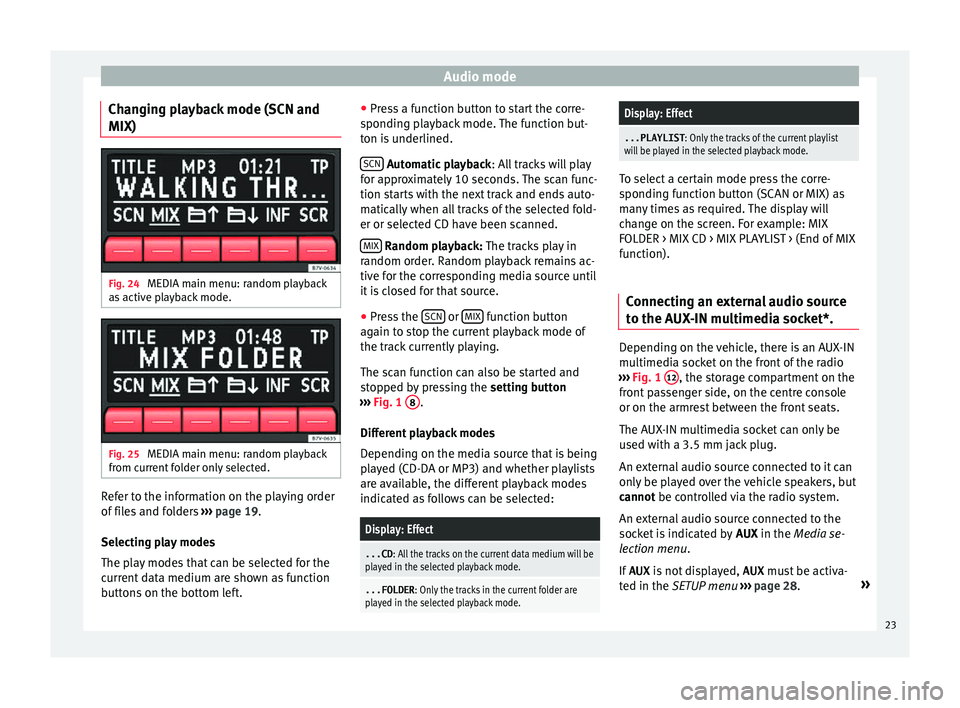
Audio mode
Changing playback mode (SCN and
MIX) Fig. 24
MEDIA main menu: random playback
a s
activ
e playback mode. Fig. 25
MEDIA main menu: random playback
fr om c
urr
ent folder only selected. Refer to the information on the playing order
of
fi
l
es and folders ›››
page 19.
Selecting play modes
The play modes that can be selected for the
current data medium are shown as function
buttons on the bottom left. ●
Pres
s a function button to start the corre-
sponding playback mode. The function but-
ton is underlined.
SCN Aut
omatic playback
: A
l
l tracks will play
for approximately 10 seconds. The scan func-
tion starts with the next track and ends auto-
matically when all tracks of the selected fold-
er or selected CD have been scanned.
MIX R
andom playback: The tracks play in
r andom or
der. Random playback remains ac-
tive for the corresponding media source until
it is closed for that source.
● Press the SCN or
MIX function button
ag ain t
o s
top the current playback mode of
the track currently playing.
The scan function can also be started and
stopped by pressing the setting button
››› Fig. 1 8 .
Diff er
ent
playback modes
Depending on the media source that is being
played (CD-DA or MP3) and whether playlists
are available, the different playback modes
indicated as follows can be selected:
Display: Effect
...CD : All the tracks on the current data medium will be
played in the selected playback mode.
...FOLDER : Only the tracks in the current folder are
played in the selected playback mode.
Display: Effect
...PLAYLIST : Only the tracks of the current playlist
will be played in the selected playback mode. To select a certain mode press the corre-
spondin
g f
unction button (SCAN or MIX) as
many times as required. The display will
change on the screen. For example: MIX
FOLDER > MIX CD > MIX PLAYLIST > (End of MIX
function).
Connecting an external audio source
to the A UX
-IN multimedia socket*. Depending on the vehicle, there is an AUX-IN
mu
ltimedi
a soc
ket on the front of the radio
››› Fig. 1 12 , the storage compartment on the
fr ont
p
assenger side, on the centre console
or on the armrest between the front seats.
The AUX-IN multimedia socket can only be
used with a 3.5 mm jack plug.
An external audio source connected to it can
only be played over the vehicle speakers, but
cannot be controlled via the radio system.
An external audio source connected to the
socket is indicated by AUX in the Media se-
lection menu.
If AUX is not displayed, AUX must be activa-
ted in the SETUP menu ›››
page 28. »
23
Page 27 of 36
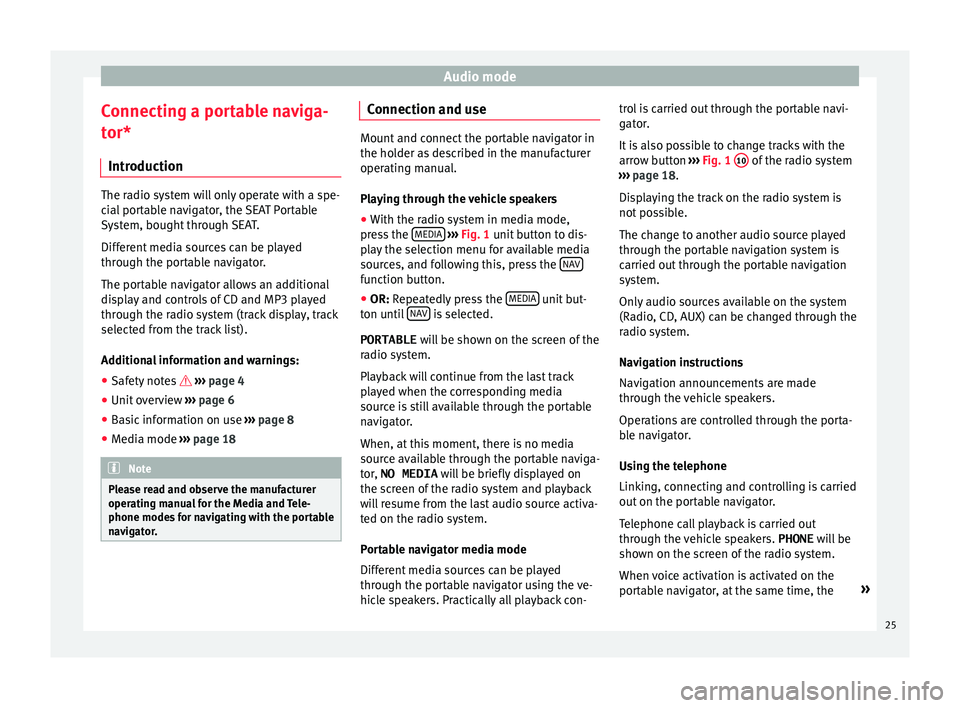
Audio mode
Connecting a portable naviga-
t or*
Intr oduction The radio system will only operate with a spe-
ci
al
portable navigator, the SEAT Portable
System, bought through SEAT.
Different media sources can be played
through the portable navigator.
The portable navigator allows an additional
display and controls of CD and MP3 played
through the radio system (track display, track
selected from the track list).
Additional information and warnings:
● Safety notes ››
›
page 4
● Unit overview ›››
page 6
● Basic information on use ›››
page 8
● Media mode ›››
page 18 Note
Please read and observe the manufacturer
operatin g m
anual for the Media and Tele-
phone modes for navigating with the portable
navigator. Connection and use
Mount and connect the portable navigator in
the hol
der a
s described in the manufacturer
operating manual.
Playing through the vehicle speakers
● With the radio system in media mode,
pres
s the MEDIA
››› Fig. 1 unit button to dis-
play the selection menu for available media
sources, and following this, press the NAV function button.
● OR: R epeatedly press the MEDIA unit but-
t on u
nti
l NAV is selected.
PORTABLE wi
l
l be shown on the screen of the
radio system.
Playback will continue from the last track
played when the corresponding media
source is still available through the portable
navigator.
When, at this moment, there is no media
source available through the portable naviga-
tor, NO MEDIA will be briefly displayed on
the screen of the radio system and playback
will resume from the last audio source activa-
ted on the radio system.
Portable navigator media mode
Different media sources can be played
through the portable navigator using the ve-
hicle speakers. Practically all playback con- trol is carried out through the portable navi-
gator
.
It is also possible to change tracks with the
arrow button ››› Fig. 1 10 of the radio system
› ›
›
page 18.
Displaying the track on the radio system is
not possible.
The change to another audio source played
through the portable navigation system is
carried out through the portable navigation
system.
Only audio sources available on the system
(Radio, CD, AUX) can be changed through the
radio system.
Navigation instructions
Navigation announcements are made
through the vehicle speakers.
Operations are controlled through the porta-
ble navigator.
Using the telephone
Linking, connecting and controlling is carried
out on the portable navigator.
Telephone call playback is carried out
through the vehicle speakers. PHONE will be
shown on the screen of the radio system.
When voice activation is activated on the
portable navigator, at the same time, the »
25
Page 29 of 36
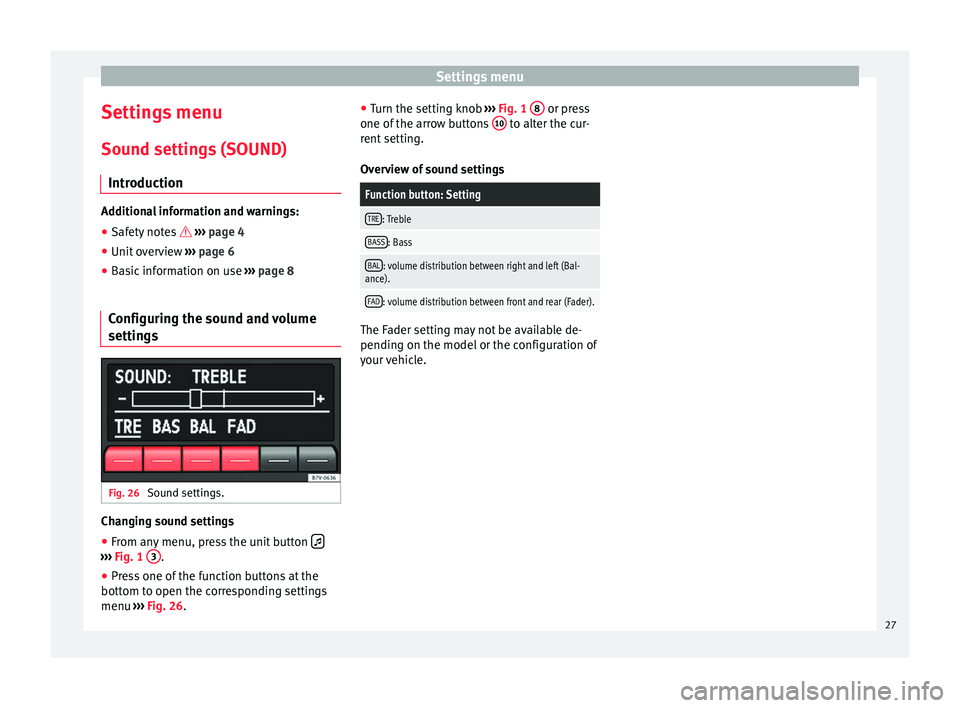
Settings menu
Settings menu Sou nd settin
g
s (SOUND)
Introduction Additional information and warnings:
● Safety notes ›››
page 4
● Unit overview ›››
page 6
● Basic information on use ›››
page 8
Configuring the sound and volume
setting s Fig. 26
Sound settings. Changing sound settings
● From any menu, press the unit button ›››
Fig. 1 3 .
● Press one of the function buttons at the
bott om t
o open the c
orresponding settings
menu ››› Fig. 26. ●
Turn the setting kno
b ››› Fig. 1 8 or press
one of the arr
o
w buttons 10 to alter the cur-
r ent
settin
g.
Overview of sound settings
Function button: Setting
TRE: Treble
BASS: Bass
BAL: volume distribution between right and left (Bal-
ance).
FAD: volume distribution between front and rear (Fader). The Fader setting may not be available de-
pendin
g on the model
or the c
onfiguration of
your vehicle. 27
Page 30 of 36
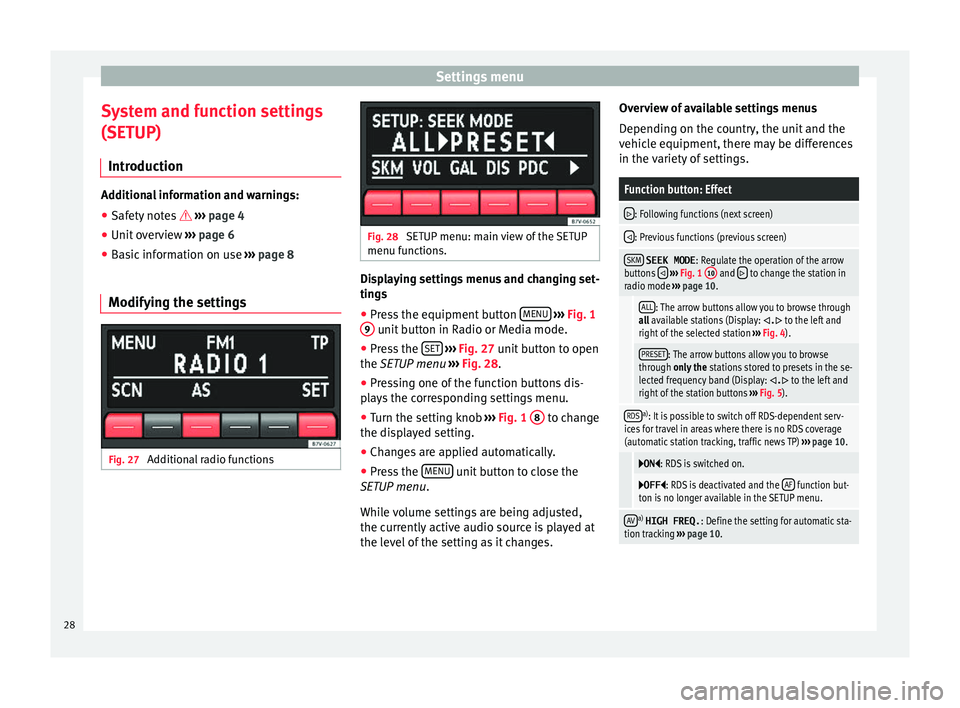
Settings menu
System and function settings
(S ETUP)
Intr oduction Additional information and warnings:
● Safety notes ››› page 4
● Unit overview ›››
page 6
● Basic information on use ›››
page 8
Modifying the settings Fig. 27
Additional radio functions Fig. 28
SETUP menu: main view of the SETUP
menu f u
nction
s. Displaying settings menus and changing set-
ting
s
● Pr
ess the equipment button MENU
› ›
› Fig. 1
9 unit button in Radio or Media mode.
● Press the S
ET
› ›
› Fig. 27
unit button to open
the SETUP menu ››› Fig. 28.
● Pressing one of the function buttons dis-
pla
ys the corresponding settings menu.
● Turn the setting knob ›››
Fig. 1 8 to change
the di s
p
layed setting.
● Changes are applied automatically.
● Press the MENU unit button to close the
S ETUP menu
.
Whi
le volume settings are being adjusted,
the currently active audio source is played at
the level of the setting as it changes. Overview of available settings menus
Depending on the c
ountry, the unit and the
vehicle equipment, there may be differences
in the variety of settings.
Function button: Effect
: Following functions (next screen)
: Previous functions (previous screen)
SKM SEEK MODE
: Regulate the operation of the arrow
buttons ››› Fig. 1 10 and to change the station in
radio mode ››› page 10.
ALL: The arrow buttons allow you to browse through
all available stations (Display: . to the left and
right of the selected station ››› Fig. 4).
PRESET: The arrow buttons allow you to browse
through only the stations stored to presets in the se-
lected frequency band (Display:
. to the left and
right of the station buttons ››› Fig. 5).
RDSa)
: It is possible to switch off RDS-dependent serv-
ices for travel in areas where there is no RDS coverage
(automatic station tracking, traffic news TP) ››› page 10.
ON: RDS is switched on.
OFF: RDS is deactivated and the
AF function but-
ton is no longer available in the SETUP menu.
AVa) HIGH FREQ. : Define the setting for automatic sta-
tion tracking ››› page 10. 28